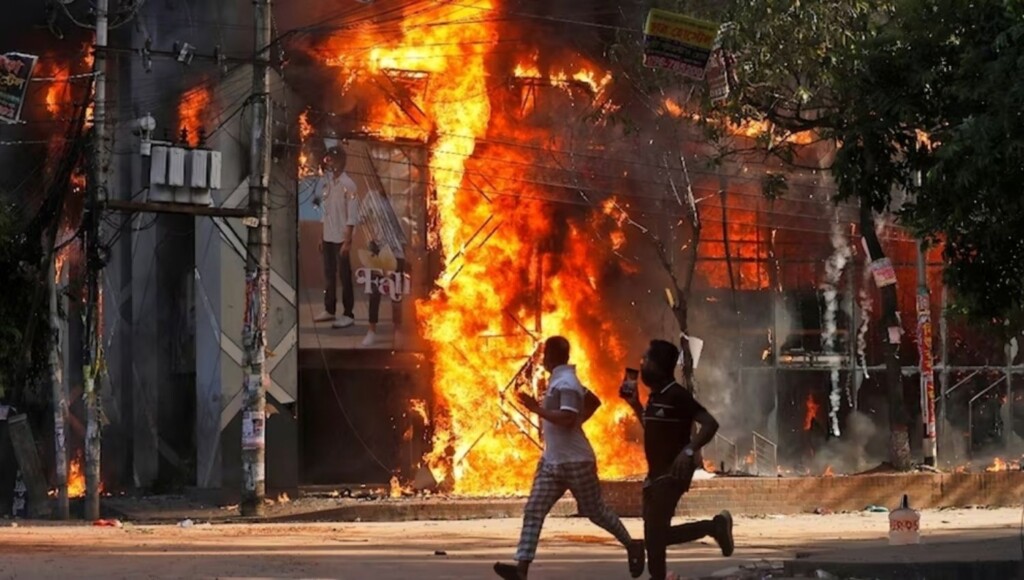After a tenure of 15 years at the helm of Bangladesh, Sheikh Hasina, often referred to as the ‘Iron Lady’, was compelled to resign and leave the country as widespread anti-government demonstrations reached a climax on Monday. The streets of Dhaka, which had experienced violence and fatalities for the preceding three weeks, erupted in celebration following her departure.
General Waker-Uz-Zaman, the chief of Bangladesh’s army, announced that a new interim government would be established shortly after discussions with political parties, excluding the former ruling party, Awami League. He assured that the violent crackdown, which resulted in over 300 fatalities, would come to an end and is scheduled to meet with student protest leaders today.
Hasina, who traveled to India aboard a military aircraft, is said to be considering seeking asylum in the United Kingdom. Nevertheless, her son, Sajeeb Wazed Joy, has dismissed these claims, stating that she does not intend to return to Bangladesh as well.
Here are the top developments:
- Sheikh Hasina left Bangladesh by helicopter, arriving at Hindon Airbase on the outskirts of Delhi on Monday. Upon her arrival, she was greeted by National Security Adviser Ajit Doval and other senior officials, who communicated India’s position regarding the ongoing situation in her home country.
- According to sources from the news agency PTI, Hasina intends to travel to London in hopes of seeking asylum. However, her plans have become uncertain following British Foreign Secretary David Lammy’s call for a comprehensive and independent investigation led by the United Nations into the recent violence in Bangladesh.
- Top sources informed India Today that Hasina has been at Hindon Airbase for the last 14 hours, awaiting the necessary clearances from the UK for her subsequent journey. During her stay, courtesy meetings are scheduled, with the Prime Minister’s Office closely observing developments.
- The situation in Bangladesh continues to be unstable, with violence persisting following Sheikh Hasina’s departure. The Inter-Services Public Relations (ISPR) has announced that all government and private offices, factories, and educational institutions are set to reopen on Tuesday.
- The chief of the Bangladesh army is scheduled to engage with leaders of the student protests on Tuesday, coinciding with the nation’s preparations for establishing a new government. The students, who initially demonstrated against job quotas and subsequently demanded the resignation of Prime Minister Hasina, are advocating for an interim administration headed by Nobel Peace Prize laureate Muhammad Yunus, as reported by the Bangladeshi newspaper Prothom Alo.
- The conclusion of Hasina’s tenure was celebrated by many, who displayed flags from the rooftops of her official residence in Dhaka. Images of protesters lounging in beds, removing furniture and valuables, and raiding the kitchen gained widespread attention on social media.
- Protesters also breached the parliament building, expressing their excitement and igniting what appeared to be smoke bombs. They engaged in looting, vandalized property, and defaced murals and statues of Hasina’s father, the former President Sheikh Mujibur Rahman.
- In a significant move, Bangladesh’s President Mohammed Shahabuddin ordered the release of former Prime Minister and prominent opposition figure Khaleda Zia shortly after the removal of her political rival, Sheikh Hasina. Zia, who leads the Bangladesh Nationalist Party, had been sentenced to 17 years in prison for corruption in 2018.
- The United States has called for a democratic and inclusive process in the formation of an interim government, urging all parties to “refrain from further violence” following weeks of deadly protests. UN Secretary-General Antonio Guterres has requested a comprehensive and independent investigation into all incidents of violence.
- Sheikh Hasina had been in power since 2009, a period characterized by notable economic growth, with the country’s GDP increasing at an average rate exceeding 6 percent annually. Nevertheless, her administration faced significant criticism for alleged human rights violations, corruption, and the suppression of political dissent.
